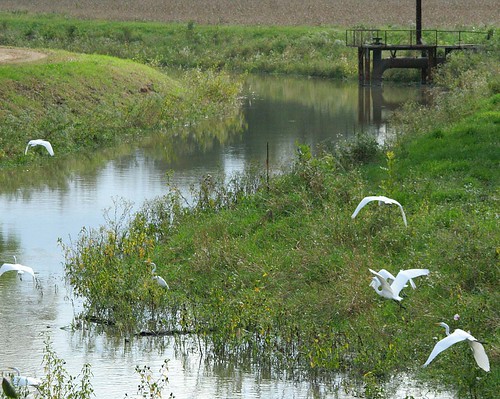I've been reading comments to some articles in the Peoria Journal Star regarding the proposed mining site near Banner, Illinois. Several comments to the stories indicate that some readers think it is fine to mine an area and reclaim it later, pointing to Banner Marsh as an example. I would like to point out that there were many, many years when the property that is now Banner Marsh was totally unsuitable for people or wildlife to inhabit.
Originally, the property that is now Banner Marsh consisted of several bottom-land lakes connected by channels to the Illinois River. Interspersed between the lakes, known then as Kelsey, Slim, Murry, Long and Scotts, were low ridges of land covered by a heavy growth of bottomland timber.
In 1910, a drainage district was organized. The Banner Marsh area of the river's floodplain was drained and leveed, enclosing about 4,500 acres. The levee broke in 1926 and 1943. It was raised and broadened after the big flood of 1943, and the river has remained on the outside since.
Sometime after that, the farmland became a strip mine, destroying any possibility of returning the land to its former configuration as a series of lake connected to the river. The strip mine operated for about 30 years. Then in 1973, the Illinois Department of Conservation purchased the first parcel of the 6,500-acre area, and 20 years later the Army Corps of Engineers spent 15 million dollars to reclaim it, starting in about 1992. It took about 10 years to do so. During all that time, from 1943 through the rest of the century, the land was in wretched condition.
The proposed mining permit area is about 600 acres, of which 400 acres are to be mined. Some of this land is farm land, some farmed wetland that floods almost
every year, some is wetland scrub/shrub, and some is wetland forest. This area is currently providing habitat for wildlife, even as it is farmed, habitat that will be destroyed during mining operations if it is allowed.
Mining is planned to take place for 5 to 10 years, depending on what company official statements you read. (The permit is for 5 years, but once a permit is granted, it is usually renewed without serious examination for another five years.) Reclamation will take at least 5 years. So we are looking at 10 to 15 years before it begins to revive to a state similar to Banner Marsh. This lengthy period of time will disrupt many sensitive species who depend on the habitat along the Illinois River corridor to survive.
* There is an American Bald eagle roost within two
tenths of a mile of the mine site, and Eagle Nests in the Rice Lake area adjacent to the site.
* There are three known osprey nests in the entire state of Illinois, one of which is in the west side of Banner, and one of which is near the proposed mining site at Rice Lake.
* Short-eared owls winter in the area, roosting in the Rice Lake area and possibly in the permit area and hunting the wide-open wetland of the the adjacent(from an owl's point of view) Banner Marsh on late winter afternoons and evenings.
The mine discharge water will be routed to Rice lake, and will contain toxic heavy metals. These tend to concentrate up the food chain, so that fish, and birds which prey on the fish will probably be at significant risk for heavy metal poisoning, as will people who consume the fish. These metals include lead, cadmium, selenium, and arsenic. Fishing and hunting at Rice Lake could be discontinued for health reasons if the mine does operate and high levels of these metals are found in the fish.
There is some indication that there may be more economic benefit to the region if we promote ecotourism. There is a wonderful group of wildlife refuges between Banner and Havana, including the Nature Conservancy's Illinois River Project at Emiquon. Dixon Mound is starting to supervise new archaeological digs in the area. The Federal Fish and Game people, the Nature Conservancy and the State fish and wildlife conservation officers are working together to provide coordinated use plans and interpretive areas for many of the protected wildlife areas (like Chautauqua and Emiquon Wildlife Preserve). People from Chicago drive down to the area frequently to view the wildlife that is thriving along the river.
Of course, the real goal of the mining company may be to get a small permit first, degrade the wildlife areas substantially and do preliminary water control on the site at this mine, and then convince the state to sell the mining rights to Rice lake itself. If that happens, we will have a huge, ugly strip mine providing jobs and polluting the Illinois River for the next thirty years.
Remember, the DNR experts who have granted this permit are largely from the Office of Mines. The Illinois Natural History Survey biologists are now associated with the University of Illinois, and other Conservation Officers have been shifted out of the Department of Natural Resources.
The major input to the decision was from the mining perspective. The Conservation Officers at Rice Lake were very much against the proposal initially (several years ago), but there has been a deafening silence since. One assumes they have been at some risk for their jobs. Some of the data offered by the petitioners against the mine came from the former supervisor of Rice Lake.
The people who live in the village of Banner will have this mine on their doorstep, in some cases within fifty yards of their back door. Their property values will plummet. They all oppose the mine. About 70 wells in the area may be at risk.
This mining permit was granted by the DNR in error, and needs to be revoked.




No comments:
Post a Comment